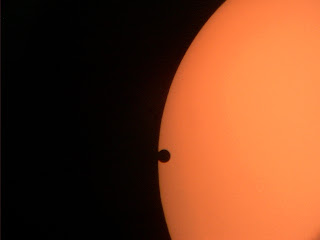This post has two purposes: to make sure everyone is aware of a really, really rare and cool astronomical event coming up, and also to share a bit about my homemade telescope.
The really, really rare and cool event you should know about is the Transit of Venus. That means that Venus will be directly between us and the sun, with its silhouette visible against the sun if you look at it through a specially equipped telescope (which I will discuss more in a minute). The event will be visible here in North America on the evening of June 5th, 2012, and it will be visible in other parts of the world on the morning of June 6th. This will be the last time in your lifetime that it will happen, unless you live until 2117. Transits of Venus happen in pairs spaced 8 years apart (this one in 2012 is the second of a pair - the first was in 2004), with more than 100 years between each pair of occurrences.
Why is this cool? I find it fascinating to be able to observe astronomical stuff - especially rare stuff - in person, with my own eyes. It's incredible to watch something as it's happening, noticing changes every few minutes - realizing that
stuff is going on up there above your head! Also, Venus is very similar in size to Earth, so it's a chance to view and comprehend the actual relative size of the sun to our planet - again, with your very own eyes. (Disclaimer: if you plan to view this event, please be sure to read the SUPER IMPORTANT WARNING at the end of this post.) I was fortunate enough to see the 2004 Transit and I took the following photos using the very low-tech method of simply holding my unsophisticated digital camera up to the eyepiece of the scope.
 |
| My stepdad, Bob, and me with our telescope, just after observing the Transit. We viewed it at a gathering that was organized by a local astronomy club. You can see the solar filter covering the end of the telescope. |
 |
| Here's another picture of us with the scope, taken the very first time we used it, up in Canada. You can see a hint of sunrise in the background - I made everyone get up EARLY so we could look at Jupiter and Saturn. It was worth it! |
Now that I'm thinking about it, I can't remember what exactly inspired us to build the telescope back in 2003. We just thought it would be neat to have one, I guess. I hunted around online and found
these plans from NASA's Telescopes in Education website (we used the ones for a 10-inch mirror). Most of the materials came from Home Depot, except the mirrors, which were ordered through
Coulter Optical (although it appears they don't offer 10-inch mirrors anymore?) and the eyepieces, which I got from
Orion Telescopes. So, I was in charge of planning, purchasing, and painting, and Bob did most of the actual construction. Also, once the telescope was complete, I was in charge of figuring out what to point it at, and how. My favorite book by far, that I used to teach myself how to use my scope and learn my way around the night sky, was
Nightwatch: A Practical Guide to Viewing the Universe by Terence Dickinson.
So, our project was a success and the scope works beautifully. These are a few of my favorite pics I took through it - again, by simply holding my digital camera up to the eyepiece of the scope. Most (all?) were taken in 2003.
 |
| Almost but not quite full moon |
 |
| Thin crescent moon |
 |
| The Sun, with a few sunspots visible. |
 |
| Sunspots, on a different day. |
 |
| My three best images of Saturn. None of them do justice to the image you see when actually looking through the scope, but at least it's recognizable! |
 |
| And this blurry thing is Jupiter. If you squint you can make out a hint of a stripe or two. And those small blurry dots to the right are some of Jupiter's moons. Again, totally doesn't do justice to what you see when you look through the scope yourself, but I had to try! |
So, if anyone in your household has the remotest interest in astronomy, research your community's resources - a local astronomy club, science museum, or maybe just a nerdy friend with a telescope - and don't miss this chance to see the Transit of Venus on June 5th - that's 3 weeks from tomorrow!
Here are a few links with more info:
Sky and Telescope
NASA
www.transitofvenus.org
SUPER IMPORTANT WARNING! If you do plan to view this event, make sure you have the proper equipment to do so safely. The links above have lots of information about that but, basically: don't look at the sun with your naked eyes, and don't look at it through a telescope, unless the scope has a
proper solar filter. That means a filter that fits over the light-gathering end of the telescope, NOT the eyepiece end. Eyepiece-type solar filters are very dangerous because they can fail (due to the extremely hot beam of focused light that your telescope points at them), causing the beam of light to enter your eye and can cause permanent damage / blindness. That would be bad. I use a filter similar to
this one.


















































